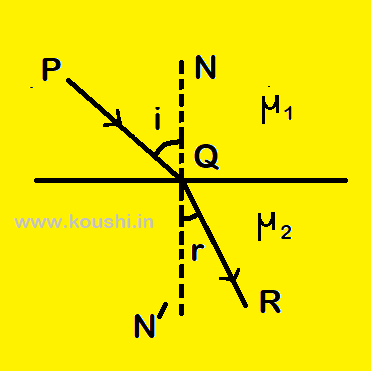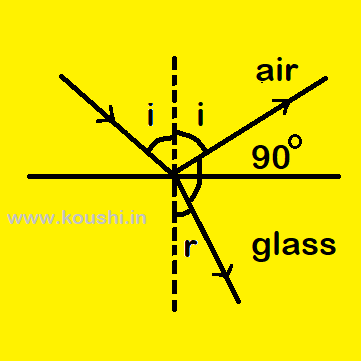

Refraction Class – XII Part – 1
- By Admin Koushi
- (0) comments
- July 7, 2025
Refraction Class – XII Part – 1
Refraction through plane surface:
Laws of refraction: 1st law – The incident ray, the refracted ray, and the normal to the interface at the point of incidence, all lie on the same plane, called the plane of incidence.
2nd law – The ratio of the sine of angle of incidence (i) to the sine of angle of refraction (r) is constant for any two given medium and one colour of light. (Snell’s law) so, ![]() = constant.
= constant.

Or, ![]() = 1µ2 =
= 1µ2 = ![]() . Where µ1 is the absolute refractive index of medium 1 in which incidence ray travels and µ2 is the absolute refractive index of medium 2 in which refracted ray travels.
. Where µ1 is the absolute refractive index of medium 1 in which incidence ray travels and µ2 is the absolute refractive index of medium 2 in which refracted ray travels.
Absolute refractive index: Absolute refractive index of a medium is defined as the ratio of speed of light in vacuum or air (c) to the speed of light in medium (v). So, µ = ![]() .
.
Relative refractive index: If medium 1 has refractive index µ1 and medium 2 has refractive index µ2 then, relative refractive index of medium 2 with respect to medium 1 is 1µ2 = ![]() .
.
Optical density of a medium: Let us consider the refractive index of medium 1 and medium 2 are respectively ![]() and
and ![]() . If
. If ![]() >
> ![]() then the medium 1 is optically denser with respect to medium 2 or medium 2 is optically rarer with respect to medium 1. If any medium is optically denser then we cannot say that the specific gravity or density of that medium is also high. The specific gravity of turpentine oil is 0.87 and that of water is 1 but refractive index of turpentine oil is 1.47 and that of water is 1.33.
then the medium 1 is optically denser with respect to medium 2 or medium 2 is optically rarer with respect to medium 1. If any medium is optically denser then we cannot say that the specific gravity or density of that medium is also high. The specific gravity of turpentine oil is 0.87 and that of water is 1 but refractive index of turpentine oil is 1.47 and that of water is 1.33.
Relation between refractive index of medium and wavelength of light: Let us consider the velocity of monochromatic ray of light in vacuum and in a medium are respectively c and v. The refractive index of medium is ![]() =
= ![]() .
.
The frequency of light is n and wavelength of it in vacuum and in medium are respectively ![]() and
and ![]() . Therefore,
. Therefore, ![]() =
= ![]() =
= ![]() .
.
Example: 1. Refractive index of glass is 1.5 and refractive index of water is 1.33. If the velocity of light in glass is 2 ![]() 108 ms-1, then what is the velocity of light in water?
108 ms-1, then what is the velocity of light in water?
Refractive index of glass with respect to air is ![]() =
= ![]()
Or, ![]() =
= ![]()
Or, c = ![]()
![]() vg —– (i)
vg —– (i)
Similarly if ![]() and Vw are the absolute refractive index and velocity of light in water, then c =
and Vw are the absolute refractive index and velocity of light in water, then c = ![]()
![]() vw —– (ii)
vw —– (ii)
From equation (i) and (ii) we get, = ![]()
![]() vg =
vg = ![]()
![]() vw
vw
Or, 1.5 ![]() 2
2 ![]() 108 = 1.33
108 = 1.33 ![]() vw
vw
![]() vw =
vw = ![]() = 2.26
= 2.26 ![]() 108 ms-1.
108 ms-1.
2. How much time will light take to pass through the glass slab of thickness d. The absolute refractive index of glass is ![]() .
.
The absolute refractive index of glass is ![]() =
= ![]() =
= ![]()
Or, vg = ![]()
If t is the time taken to travel the distance d by light then, vg = ![]()
Or, ![]() =
= ![]()
![]() t =
t = ![]() .
.
3. A ray of light is incident on glass slab from air in such a way that the angle between the reflected and refracted ray is 900. What is the relation between the angle of incidence and the refractive index of glass?
Let us consider the angle of incidence and angle of reflection are i and angle of refraction is r. As the angle between reflected and refracted ray is 900 then, i + r + 900 = 1800
Or, r = 900 – i
If ![]() is the refractive index of glass with respect to air then using Snell’s law we get,
is the refractive index of glass with respect to air then using Snell’s law we get, ![]() =
= ![]()
Or, ![]() =
= ![]()
![]()
![]() =
= ![]() = tani.
= tani.

Deviation of a ray during refraction: Whenever a ray of light travels from one medium to another medium it deviates from its path. The angle between the refracted ray and the direction of the incident ray gives the measurement of deviation.
Let us consider AO is the incident ray and OB is the refracted ray where i and r are the angle of incidence and angle of refraction respectively.
When light travels from rarer medium to denser medium, ![]() BOC is the angle of deviation. So,
BOC is the angle of deviation. So, ![]() BOC =
BOC = ![]() CON/ –
CON/ – ![]() BON/
BON/
Or, ![]() =
= ![]() AON –
AON – ![]() BON/
BON/
Or, ![]() = i – r
= i – r

When light travels from denser medium to rarer medium, ![]() BOC is the angle of deviation. So,
BOC is the angle of deviation. So, ![]() BOC =
BOC = ![]() BON/ –
BON/ – ![]() CON/
CON/
Or, ![]() =
= ![]() BON/ –
BON/ – ![]() AON
AON
Or, ![]() = r – i
= r – i

Example: A ray of light is incident on a plane of a glass slab from air at an angle 450 and due to refraction the ray is deviated through an angle 150. Calculate the refractive index of the glass slab.
As light travels from rarer medium to denser medium, then angle of deviation is ![]() = 450 – 150 = 300
= 450 – 150 = 300
Using Snell’s law we get, refractive index of glass slab ![]() =
= ![]() =
= ![]() = 1.414.
= 1.414.
Principle of reversibility of light: When a light travels from medium 1 to medium 2 along the path AOB, AO is the incident ray and OB is the refracted ray. Using Snell’s law ![]() = 1µ2 —–(1)
= 1µ2 —–(1)
Example: A ray of light is incident on a plane of a glass slab from air at an angle 450 and due to refraction the ray is defeated through an angle 150. Calculate the refractive index of the glass slab.
As light travels from rarer medium to denser medium, then angle of deviation is ![]() = 450 – 150 = 300
= 450 – 150 = 300
Using Snell’s law we get, refractive index of glass slab ![]() =
= ![]() =
= ![]() = 1.414.
= 1.414.
Principle of reversibility of light: When a light travels from medium 1 to medium 2 along the path AOB, AO is the incident ray and OB is the refracted ray. Using Snell’s law ![]() = 1µ2 —–(1)
= 1µ2 —–(1)

Click the button to go to the next part of this chapter.

